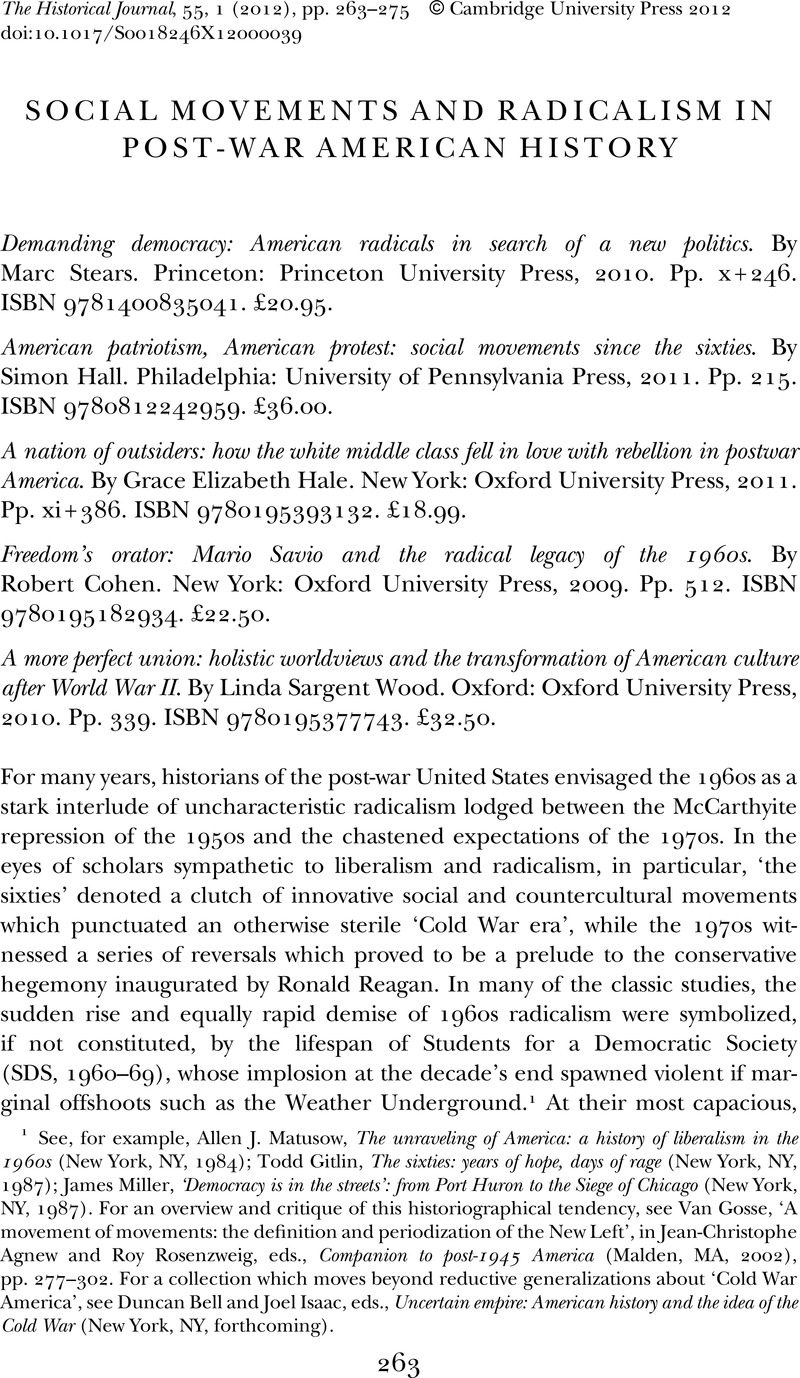Article contents
SOCIAL MOVEMENTS AND RADICALISM IN POST-WAR AMERICAN HISTORY
Published online by Cambridge University Press: 10 February 2012
Abstract

- Type
- Review Articles
- Information
- Copyright
- Copyright © Cambridge University Press 2012
References
1 See, for example, Matusow, Allen J., The unraveling of America: a history of liberalism in the 1960s (New York, NY, 1984)Google Scholar; Gitlin, Todd, The sixties: years of hope, days of rage (New York, NY, 1987)Google Scholar; Miller, James, ‘Democracy is in the streets’: from Port Huron to the Siege of Chicago (New York, NY, 1987)Google Scholar. For an overview and critique of this historiographical tendency, see Van Gosse, ‘A movement of movements: the definition and periodization of the New Left’, in Jean-Christophe Agnew and Roy Rosenzweig, eds., Companion to post-1945 America (Malden, MA, 2002), pp. 277–302. For a collection which moves beyond reductive generalizations about ‘Cold War America’, see Bell, Duncan and Isaac, Joel, eds., Uncertain empire: American history and the idea of the Cold War (New York, NY, forthcoming)Google Scholar.
2 Fredric Jameson, ‘Periodizing the 60s’, in Sohnya Sayres, Anders Stephanson, Stanley Aronowitz, and Fredric Jameson, eds., The sixties without apology (Minneapolis, MN, 1984), pp. 178–209; Lytle, Mark Hamilton, America's uncivil wars: the sixties era from Elvis to the fall of Richard Nixon (New York, NY, 2006)Google Scholar.
3 Further examples of this literature include Petigny, Alan, The permissive society: the United States, 1941–1965 (Cambridge, 2009)Google Scholar; Andrew Hunt, ‘How new was the New Left?’, in John MacMillan and Paul Buhle, eds., The New Left revisited (Philadelphia, PA, 2003), pp. 139–55; Hall, Jacquelyn Dowd, ‘The long civil rights movement and the political uses of the past’, Journal of American History, 91 (2005), pp. 1233–63CrossRefGoogle Scholar. For an overview of recent scholarship re-examining the 1970s, see Tuck, Stephen, ‘Introduction: reconsidering the 1970s – the 1960s to a disco beat?’, Journal of Contemporary History, 43 (2008), pp. 617–20CrossRefGoogle Scholar.
4 For a transnational view of 1960s protest, see Suri, Jeremi, Power and protest: global revolution in the age of détente (Cambridge, MA, 2003)Google Scholar. For the wider transnational turn in American history, see Bender, Thomas, ed., Rethinking American history in a global age (Berkeley, CA, 2002)CrossRefGoogle Scholar.
5 Lassiter, Matthew D., The silent majority: suburban politics in the sunbelt south (Princeton, NJ, 2006)Google Scholar; McGirr, Lisa, Suburban warriors: the origins of the new American right (Princeton, NJ, 2001)Google Scholar.
6 On the prevalence of working-class students within the anti-war movement, see Heineman, Kenneth J., Campus wars: the peace movement at American state universities in the Vietnam era (New York, 1993)Google Scholar.
7 Isserman, Maurice and Kazin, Michael, America divided: the civil war of the 1960s (New York, 2000)Google Scholar.
- 2
- Cited by


